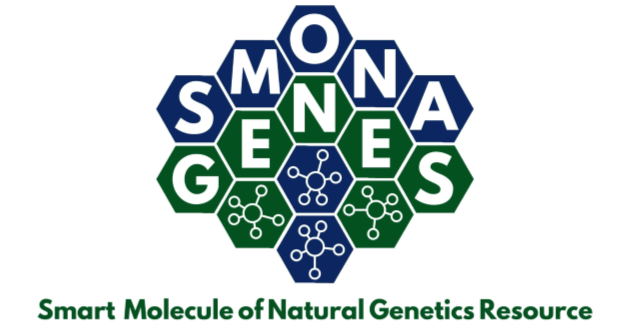In Silico Analysis of rbcl Protein and D-Ribulose 1,5-bisphosphate Bond
DOI:
https://doi.org/10.21776/ub.jsmartech.2021.002.02.65Keywords:
Insilico, rbcL protein, ribulose, biphosphateAbstract
The aim of this study was to determine the bond between the protein rbcL and D-Ribulose 1,5-bisphosphate by insilico. DNA sequences of the Mangrove Rhizophora mucronate rbcL gene DNA sequences from 7 different sources were obtained from NCBI for further alignment analysis using BioEdit software, phylogeny analysis using Mega6 software, molecular docking using PyRx software, preparation and visualization of docking results using Biovia Discovery Studio Visualizer software and analysis of the protein model quality based on the number of amino acid residues (Ramachandran plot analysis). The results of the docking molecular analysis showed interaction of 9 hydrogen bonds namely Asp203, Thr173, His294, Glu204, His327, Ser379, His298, Arg295, and Asn123 and 2 unfavorable bonds namely Lys177 and Lys175. This ligand and protein interaction complex was of good quality because the presence of amino acid residues in the most favored regions was greater than the amino acid residues in the disallowed regions outcomesReferences
Provan J, Powell W, Hollingsworth PM. 2001. Chloroplast microsatellites: New tools for studies in plant ecology and evolution. Trends Ecol Evol,16(3):142–7.
Snustad, D.P and M.J. Simmons. 2015. Principles of Genetiks (Seventh Edition). Massachusetts: The McGrawHill Companies.
Pierce, B. A. 2017. Genetics: A Conceptual Approach (seventh edition). New York: W. H. Freeman and Company.
Hebert PDN, Cywinska A, Ball SL, DeWaard JR. 2003. Biological identifications through DNA barcodes. Proc R Soc B Biol Sci.270(1512):313–21.
P Hollingsworth, P. M., L. L. Forrest, J. L. Spouge, M. Hajibabaei, and R. Ratnasingham. 2012. A DNA barcode for land plants area. 106(31):12794–7.
Kellogg EA, Juliano ND. 1997. The structure and function of RuBisCO and their implications for systematic studies. Am J Bot.84(3):413–28.
Fazekas AJ, Burgess KS, Kesanakurti PR, Graham SW, Newmaster SG, Husband BC, et al. 2008. Multiple multilocus DNA barcodes from the plastid genome discriminate plant species equally well. PLoS One, 3(7).
Cummings MP, Nugent JM, Olmstead RG, Palmer JD. 2003. Phylogenetic analysis reveals five independent transfers of the chloroplast gene rbcL to the mitochondrial genome in angiosperms. Curr Genet., 43(2):131–8.
Petsko, G.A., & D. Ringe. 2004. Protein structure and function: from sequence to consequence. New Science Press Ltd, London.
Ho BK, Brasseur R. 2005. The Ramachandran plots of glycine and pre-proline. BMC Struct Biol.,5:1–11.
Y Bare, S Mansur, SSND Tiring, DRT Sari, A Maulidi. 2020. Virtual screening: prediksi potensi 8-shogaol terhadap c-Jun N-Terminal Kinase (JNK). Jurnal Penelitian dan Pengkajian Ilmu Pendidikan: e-Saintika, 4 (1), 1-6
DRT Sari, JRK Cairns, A Safitri, F Fatchiyah. 2019. Virtual Prediction of the Delphinidin-3-O-glucoside and Peonidin-3-O-glucoside as Anti-inflammatory of TNF-α Signaling. Acta Informatica Medica, 27 (3), 152-157.
DRT Sari, A Safitri, JRK Cairns, F Fatchiyah. 2020. Anti-apoptotic activity of anthocyanins has potential to inhibit caspase-3 signaling. Journal of Tropical Life Science, 10 (1), 15-25.
Downloads
Published
Issue
Section
License
Authors who publish with this journal agree to the following terms:
- Authors retain copyright and grant the journal right of first publication with the work simultaneously licensed under a Creative Commons - Attribution 4.0 International (CC BY 4.0) that allows others to share the work with an acknowledgement of the work's authorship and initial publication in this journal.
- Authors are able to enter into separate permission for non-exclusive distribution of the journal's published version of the work (e.g., post it to an institutional repository or publish it in a book), with an acknowledgement of its initial publication in this journal.
- Authors are permitted and encouraged to post their work online (e.g., in institutional repositories or on their website) prior to and during the submission process, as it can lead to productive exchanges, as well as earlier and greater citation of published work (See The Effect of Open Access).












